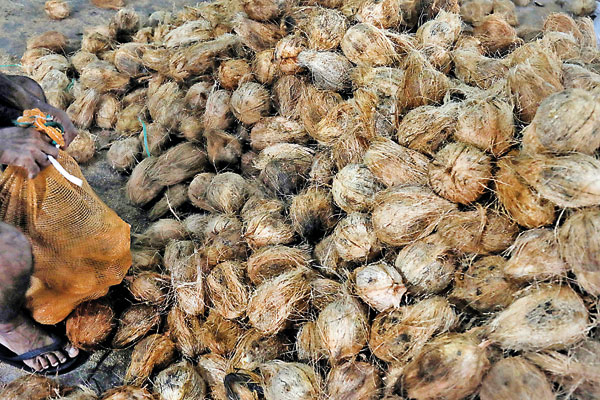News
Coconut production drops sharply, while exporters rake in billions
View(s):By Kapila Bandara
Sri Lankan exporters have shipped coconut and products based on coconuts worth US$782.32 million (Rs 228.84 billion) in the 11 months to November amid a severe domestic shortage, a sharp drop in production this year, and a substantial retail price increase of nuts as well as that of coconut oil.
Data from the Export Development Board show that export earnings of coconut and products based on coconut shot up at a high double-digit rate from January to November.
In November, exports of coconut oil, desiccated coconut, coconut milk powder, coconut cream, liquid coconut milk, as well as coco peat, and activated carbon all recorded high double-digit increases.
Earnings from coco peat, fiber pith and moulded products were US$13.56m (Rs 3.96b) in November. This category of coconut fibre products is identified as the largest contributor.

From January to September, yield has fallen to 2.28 billion nuts, a drop of 4% from the same period a year ago. Pic by M.A. Pushpa Kumara
While container loads go often at free on board prices, Sri Lankans are yet again paying prices of up to Rs 170 for coconuts due to a lingering, unresolved, and predictable shortage that surfaces every year.
Citing data from Coconut Development Authority, Department of Census and Statistics, World Bank, the agriculture bulletin for November by the Central Bank of Sri Lanka, shows a 17.8% year-on-year drop in September coconut production.
Other data show that monthly coconut production has dropped from a peak of 280m nuts in March this year to 220m nuts in September.
From January to September, yield has fallen to 2.28 billion nuts, a drop of 4% from the same period a year ago.
Coconut oil production has also shrunk by 33.2% on-year to 23,789 metric tonnes. A domestically made 500ml ‘white’ coconut oil bottle sells for up to Rs 850 at retail.
In 2023, monthly coconut production tumbled from a peak of less than 280m nuts in February-March to below 260m nuts in December.
In 2022, production plunged to well below 280m nuts in December from a peak of 380m nuts in June.
Four years ago in September, then coconut minister Arundika Fernando climbed a tree in Dankotuwa using a pricey, Rs 19,000 mechanical contraption during a shortage and high prices. He promised to “boost the industry’’ while suspended on the tree.
He spoke of a shortage of 700m nuts and insisted that even fallow land will be cultivated. Coconuts will be turned into the “biggest” export earner he boasted.
At the time, coconuts were being graded by measuring tape to determine prices — a nut with a circumference of more than 13 inches was priced at Rs. 70, between 12’’ and 13’’ at Rs. 62, and below 12’’ at Rs 60.
The Coconut Development Authority noted then a shortage of 250 million nuts, citing low yield. Production last year was 3.17b nuts.
A year after Mr Fernando’s much-derided tree stunt, the price of a coconut had surged by more than 41% from Rs 60 to Rs 85 on average at retail. And, in September 2022, nuts were selling at Rs 90 at the Pettah market and Rs 96 in Narahenpita. Then, in 2023 September, a nut cost Rs 120 on average. The price had rocketed by 100% in three years.
In October 2023, monthly nut production had dropped to 268.1m from the year before. It was a 4.3% fall on-year.
The production slide continued. In December 2023, production had shrunk to 254.1m nuts, a 6.4% fall on-year.
By this past September, a coconut on average cost Rs 130 in the Pettah market. At Narahenpita Economic Centre a nut changed hands at Rs 135. These do not reflect the actual price homemakers pay for a nut.
In July 2024, nut production had edged up to 272.7m versus 265m the year before.
And yet, a coconut costs relatively less than a kilo of kolikuttu at prices between Rs 400 and Rs 600, compared with Rs 200 per kilo in 2020. A large pineapple costs about Rs 900 a kilo. Sugar costs up to Rs 262 plus a kilo at retail.
The price of coconut oil changes in tandem with that of coconuts. Production has fallen by more than 33% from 35,589 MT in January to September 2023 to 23,789 MT in January to September this year.
On 26 December, ‘white’ coconut oil traded between Rs 990,000 and Rs 1.05m for a metric tonne.
The best way to say that you found the home of your dreams is by finding it on Hitad.lk. We have listings for apartments for sale or rent in Sri Lanka, no matter what locale you're looking for! Whether you live in Colombo, Galle, Kandy, Matara, Jaffna and more - we've got them all!

